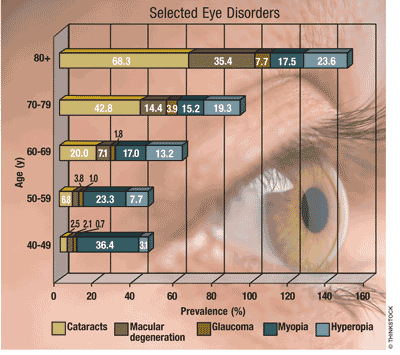US Pharm. 2011;36(4):2.
Half of the estimated 61 million U.S. adults are at high risk for serious vision loss and have visited an eye doctor in the past 12 months. The National Eye Institute (NEI) reports that vision loss from eye diseases continues to increase as the population ages. The number of people who are blind or have low vision is projected to increase substantially by 2020. According to the NEI, the most common eye diseases in Americans 40 years and older are age-related macular degeneration (prevalence, 1.6 million; 2020 projection, 2.9 million); glaucoma (prevalence, 2.2 million; 2020 projection, 3.3 million); cataracts (prevalence, 20.5 million; 2020 projection, 30.1 million); and diabetic retinopathy (prevalence, 5.3 million; 2020 projection, 12.5 million).

Cataracts are the leading cause of low vision in Americans, responsible for about 50% of all cases. The prevalence of glaucoma rises rapidly in Hispanic individuals over age 65 years, and this disease is three times as common in African American individuals as in white individuals. Although age-related macular degeneration is strongly associated with increasing age (particularly after age 60 years), its prevalence rises dramatically in white individuals older than 80 years.
Visual Impairment: Visual impairment with visual acuity less than 20/50 affects 14 million people, and 92% (11 million) of these have the potential for improvement to 20/40 by using refractive correction. Among individuals over 50 years of age, visual impairment is doubled (24%) among patients with diabetes compared with those without diabetes (12%). Among individuals aged 20 years and older with diabetes, 11% suffer from visual impairment and 7% have correctable conditions. In contrast, among patients without diabetes, 6% have some form of visual impairment, 4.5% of them with correctable conditions. One in 12 diabetic patients aged 40 years and older has vision-threatening diabetic retinopathy.
Blindness: According to the NEI, blindness and low vision (visual acuity £20/200) affect 3.3 million people (3%)—or 1 in 28—aged 40 years and older. The prevalence of blindness is projected to reach 5.5 million (a 67% increase) by 2020. Low vision and blindness increase significantly with age, particularly in people over 65 years of age. People aged 80 years and older currently make up 8% of the population, but they account for 69% of blindness. Age-related macular degeneration, which accounts for 54% of all blindness, is the leading cause of blindness among white individuals (1 in 10). Among African American patients, the leading causes of blindness are cataracts and glaucoma; among Hispanic patients, glaucoma is the most common cause.
To comment on this article, contact rdavidson@uspharmacist.com.






